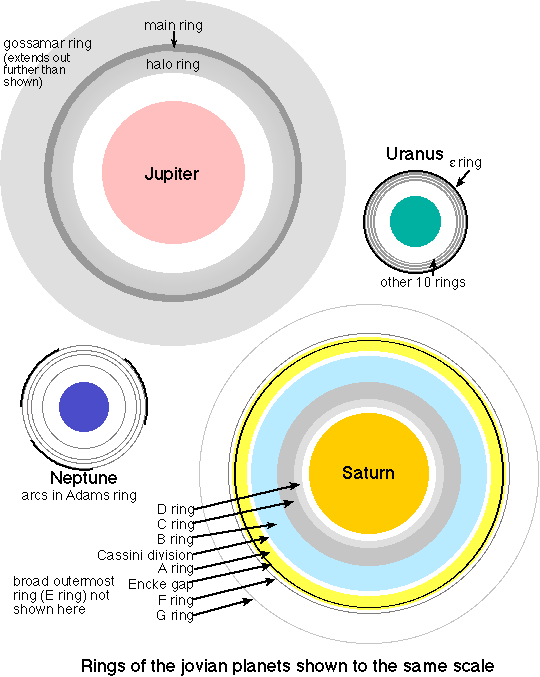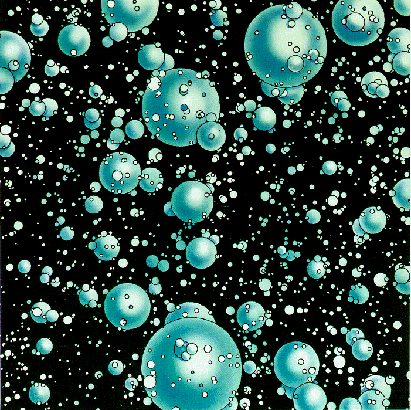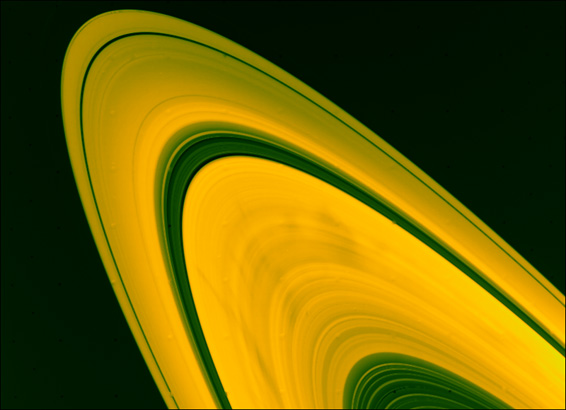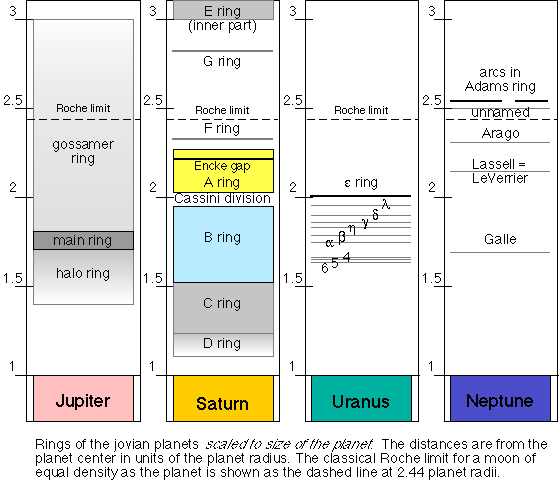
This material (including images) is copyrighted!. See my copyright notice for fair use practices. Select the photographs to display the original source in another window.

All of the jovian planets have a system of rings. Jupiter has four faint rings: a flattened main ring, a puffier inner ring, and two wispy outer rings that are inside the orbit of Io. The rings are made of very small, dark particles the size of smoke particles. They are produced by dust kicked up from the tiny innermost moons of Jupiter by impacts on the moons. They were discovered when Voyager 1 flew by Jupiter in 1979 and looked back in the direction of the Sun to detect the scattering of sunlight off of the tiny particles.
Upper left-center is the Galileo spacecraft's view of Jupiter's faint rings when looking back toward the Sun---the best position for viewing very faint rings made of tiny particles. The lower right graphic is a description of the rings and where they are with respect to some small moons very close to Jupiter. Jupiter's ring system is composed of three parts: an outermost gossamer ring, a flat main ring, and an innermost donut-shaped halo.
Saturn's rings were discovered by Christian Huygens in 1659. Galileo's telescope was too small to make them look like more than just a couple of bumps on either side of the planet. In 1675 Giovanni Cassini discovered a gap between the two large (A & B) rings, now called the Cassini division in his honor. With improved telescopes, astronomers were able to see that one of the large rings was in fact, two rings (B & C) and there is a gap in the A ring (the Encke division). There is also a hint of another ring closer to the planet than the C ring (the D ring). When the Pioneer and Voyager spacecraft flew by, astronomers found more rings and complex structure in the rings.
The rings that are visible in even low-power telescopes on the Earth (A, B, and C) extend from about 74,000 kilometers to about 137,000 kilometers from Saturn's center (or 1.23 to 2.28 Saturn radii). The rings are very thin, less than a hundred meters thick. A scale model of the rings with the width equal to a single piece of regular paper would be about 100 meters across! Collisions between the ring particles keeps the ring system very flat and all of the particle orbits circular. In 1859 James C. Maxwell (of electromagnetism fame), showed that the rings could not be solid, but, rather a swarm of particles. A solid ring the width of Saturn's ring system would become unstable and break up. James Keeler proved Maxwell correct in 1895 when he measured the doppler shifts of different parts of the rings and found that the outer parts of the ring system orbited at a slower speed than the inner parts. The rings obeyed Kepler's third law and, therefore, must be made of millions of tiny bodies each orbiting Saturn as a tiny mini-moon. Spectroscopy of the rings shows that the particles are made of frozen water.

More recently, astronomers bouncing radar off the rings and analyzing the reflected signal indicated that the ring particles must be from a few centimeters to a few meters across. When the Voyager spacecraft went behind the rings with respect to the Earth, astronomers could measure the particles sizes from how Voyager's radio signal scattered off the particles and from how sunlight scattered through the rings. The Cassini spacecraft that orbited Saturn for 13 years made many such observations. The ring particles range in size from the size of a small grain of sand to the size of a mountain but, on average, they are about the size of your clenched fist. The effect of particle size on how the particles scatter sunlight is nicely illustrated in the iconic image below as well as in a movie made by Cassini crossing the ring plane from above to below. The Sun is behind Saturn and Cassini is in Saturn's shadow.
Very small particles will scatter sunlight forward while larger particles will scatter the sunlight backward. Recall how the very fine dust on the inside of your car's windshield will make it nearly impossible to see through it when you are driving toward the Sun. People on the outside of your car are able to easily see you inside through your windshield because there is not any backscattering of the sunlight. They would have a much harder time seeing you though, if the outside of your windshield was coated with grittier dust and dirt. The Voyager and Pioneer spacecraft confirmed the presence of the inner D ring and discovered two other rings beyond the outer A ring: a narrow F ring just outside the A ring and a broad, but faint E ring. Cassini added another two rings with this image: a ring that shares the same orbit as Janus and Epimetheus and another that shares the same orbit as Pallene. Micro-meteorite impacts on these moons chip off material to feed their namesake rings. The E-ring is supplied by the geysers of Enceladus. This forward scattering process by very small particles is also why Jupiter's rings were not discovered until the Voyager flyby in 1979.
The broad rings we see from the Earth are actually systems of thousands of tiny ringlets each just a few kilometers wide, so the rings look like grooves in a phonograph record (youngsters only familiar with CD's will have to ask their parents or grandparents about them). Voyager also found some unusual things in Saturn's ring system: rings that change shape, eccentric ring shapes (some even twist around each other to make a braid), and dark features that look like spokes extending radially outward across the rings. Cassini studied these features and also discovered features that look like propellers that can get up to several thousand kilometers long (see the image below). The propellers form by the gravitational interaction of small moonlets in the rings with the surrounding ring material. The moonlets create a wake both behind and in front of the moonlet as it orbits because the ring material nearer Saturn moves faster than the moonlet while the ring material farther from Saturn moves slower.
The grooved pattern of Saturn's rings are probably the result of spiral density waves forming from the mutual gravitational attraction of the ring particles. Narrow gaps in the rings are swept clean of particles by small moonlets embedded in the rings. The tiny moons can also act as shepherd satellites. Two shepherd satellites with one orbiting slightly outside the other satellite's orbit can constrain or shepherd the ring particles to stay between the moonlet orbits. The narrow F ring is the result of two shepherd satellites, Pandora and Prometheus, between 80 and 100 kilometers across with orbits about 1000 kilometers on either side of the F ring. Prometheus and Pandora also responsible for the braids and kinks in the F ring. The dark drapes in the image below were created by Prometheus as its gravity tugged on F ring material at its closest approach to the F ring. See the movie of this in process by selecting the picture (link to propeller source image)

Bigger gaps in the rings (such as the Cassini division) are the result of gravitational resonances with the moons of Saturn. A resonance happens when one object has an orbital period that is a small-integer fraction of another body's orbital period, e.g., 1/2, 2/3, etc. The object gets a periodic gravitational tug at the same point in its orbit. Just as you can get a swing to increase the size of its oscillation by pushing it at the same point in its swing arc, a resonance can ``pump up'' the orbital motion of an object. Particles at the inner edge of the Cassini division are in a one-two resonance with the moon called Mimas---they orbit twice for every one orbit of Mimas. The repeated pulls by Mimas on the Cassini division particles, always in the same direction in space, force them into new orbits outside the gap. Other resonances with Mimas are responsible for other features in Saturn's rings: the boundary between the C and B ring is at the 1:3 resonance and the outer edge of the A ring is at the 2:3 resonance. It is amazing what a simple inverse square law force can do!
The dark spokes in Saturn's B ring were a surprise. The different orbital speeds of the ring particles should quickly shear apart any radial structure in the rings, but the spokes clearly survived the shearing! The spokes are probably caused by very tiny dust particles hovering just above the rings by their interaction with Saturn's magnetic field or by electrostatic forces created from ring particle collisions. The spokes look dark because they are scattering light in the forward direction (away from the spacecraft) and are most easily seen near Saturn's equinox times that occur roughly every 15 years.
Where did the rings of Saturn come from? Studies of the various forces on the ring particles show that the rings are transient---they did not form with Saturn as part of the formation of the main planet, nor will they always be there. Cassini's measurements of the mass of the rings and the rate that dust is accumulating on them to darken them indicate a young age of only about 100 to 200 million years (though the estimates are uncertain). Another study combining results from Cassini, the Voyager 1 and 2 flybys in the early 1980s and ground-based telescope observations has found Saturn's rings are being drained of material as a dusty rain falls from the rings into Saturn's atmosphere at a rate that means the rings will be gone in about 100 million years. Furthermore, if the observed rate of rain has been the same as today, then the C-ring would have been as dense as the B-ring just 100 million years ago---we're seeing the rings at their mid-life.
The rings of Saturn are within the distance at which a large moon would experience extreme enough tidal stretching to be torn apart. This distance is called the Roche limit, after M.E. Roche who developed the theory of tidal break up in the 1849. The exact distance of the Roche limit depends on the densities of the planet and close-approaching moon and how strongly the material of the moon is held together. The classical Roche limit considers a moon held together only by its internal gravity. Such a moon would break up at a distance of about 2.44 planetary radii from the center of the planet.
Saturn's rings lie within Saturn's Roche limit so it is likely that they were formed by particles too close to Saturn to ever form a large moon. The fact that all of the jovian planets have rings argues against the breakup of a large moon spiraling in toward Saturn from a rare encounter with an object passing through the moon system. (Maybe it could happen with one planet, but with all four jovians?) Another possibility is that large collisions on the large moons outside the Roche limit spewed material into the region inside the Roche limit. One variation of this involves the sun's gravity perturbing small moons inside of Rhea's orbit and getting them to violently collide and break apart. Material from the smashup outside the Roche limit coalesced to form the inner moons while material inside the Roche limit formed the rings. However, that means the inner moons, Enceladus, Dione, and Mimas would have to be just 200 million years old (assuming the ring age given above) and their complex, cratered surfaces appear to be much older than that.
Small moonlets are able to exist in the rings because the tidal stretching across their small diameters are too small. Tidal forces will prevent them from getting large. Collisions among themselves and micro-meteorite impacts can replenish a ring. Some the ring material may be able to clump together to create the moonlets and that may be why some of the moonlets have significant equatorial ridges to make them look like "flying saucers". (Are these pictures making the rounds on the internet as "proof" of aliens?)
Saturn's E ring lies outside Saturn's Roche limit and is most concentrated at the orbit of the icy moon, Enceladus. Eruptions of water vapor from Enceladus are the source of the E ring material. The image below shows the geysers erupting out of Enceladus' south polar region (extra bright material below the dark circle of Enceladus) and the shadow of Enceladus casting onto the E-ring material in which Enceladus orbits.

Uranus' rings were discovered in 1977 from measuring the intensity of light from a star as Uranus passed in front of it. Astronomers were originally intending to learn about Uranus' atmosphere from how the light passed through the top cloud layers and to measure both the diameter of Uranus and the star accurately from timings of when the star was totally blocked. They noticed that the star blinked off and on before Uranus itself passed in front of the star. The star also blinked off and on after Uranus itself had moved out of the way. The symmetry of the winking out of the star as the rings passed in front of the star pointed to their existence. Later infrared observations gave astronomers more information about them. Neptune's rings were discovered in the same way a few years after the Uranus' rings discovery. Voyager 2 gave a much better view of the rings when it flew by Uranus in 1986 and Neptune in 1989.
|
Hubble Space Telescope view of Uranus, its four major rings and ten of its satellites with its near-infrared camera. A visible light image of the rings would not be so impressive. Colors of Uranus indicate altitude: green and blue are the deeper layers, yellow and grey are higher haze and clouds, and orange and red are very high cirrus clouds. |
Voyager 2's view of Uranus' rings when seen looking back toward the Sun. This image has been colorized: real color is gray and they are as dark as charcoal. See the image link for the how this image was processed. |
The rings of Uranus and Neptune are much darker than Saturn's rings, reflecting only a few percent of what little sunlight reaches them (they are darker than pieces of black, burned wood) while Saturn's rings reflect over 70% of the Sun's light. The rings are also much narrower than Saturn's rings. Uranus' outermost and most massive ring, called the Epsilon Ring, is only about 100 kilometers wide and probably less than 100 meters thick. The other ten dark and narrow rings have a combined mass less than the Epsilon Ring. The six rings of Neptune are less significant than Uranus' and the ring particles are not uniformly distributed in the rings. Like Saturn's F ring, the rings of Uranus and Neptune are kept narrow by shepherd satellites. The narrowness and even clumpiness of the rings means that the rings can last for only a short time---a million years or so, unless the rings are replenished by material ejected off the moons in large collisions.
Neptune's rings as seen by Voyager 2 when looking back toward the Sun. Bright Neptune has been blocked out with the center bar. Two different exposures are combined for this image, each 591 seconds long and separated by 1 hour 27 minutes.
![]() Go back to previous section --
Go back to previous section --
![]() Go to next section
Go to next section
last updated: June 30, 2023